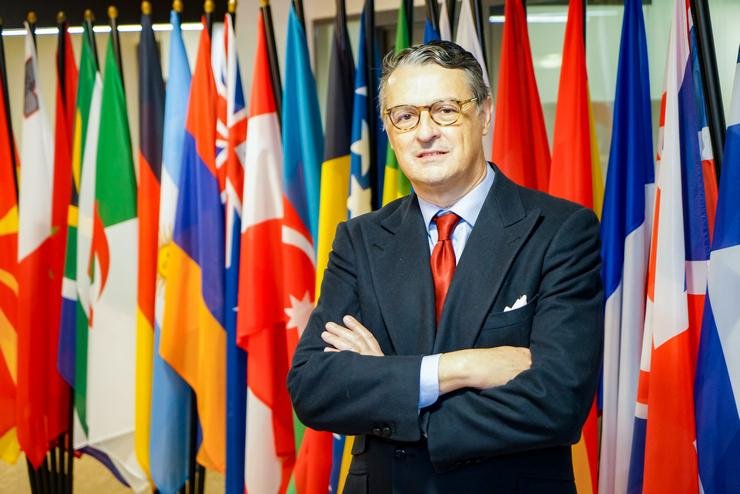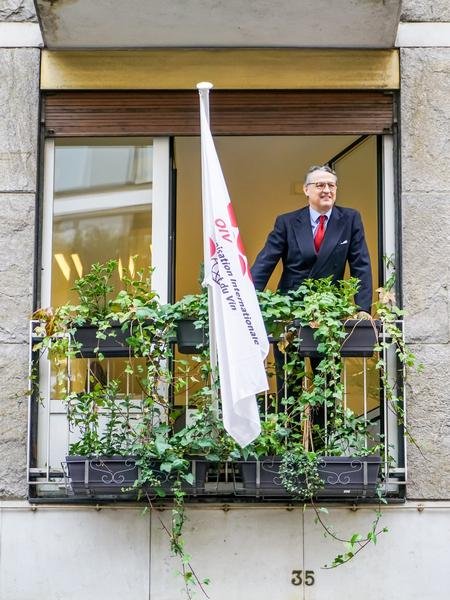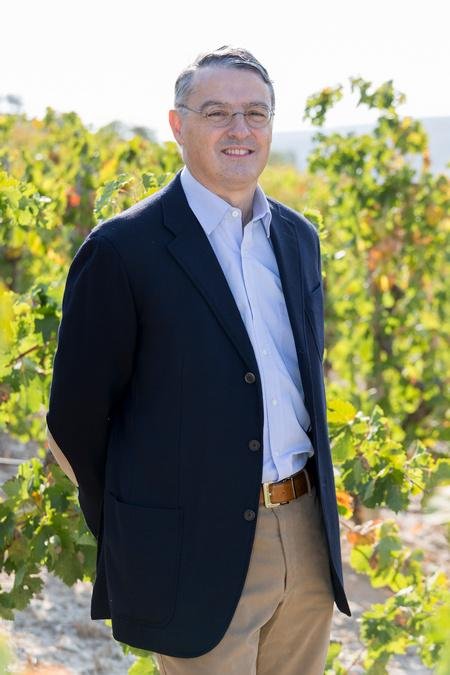
На сайте используются cookie файлы
The site uses cookie files
Данный сайт имеет возрастное ограничение!
This site has age restrictions!
Я подтверждаю, что мне, увы, уже давно исполнилось 18 лет
Editor-in-chief of Drinks+ managed to interview Director General of the International Organisation of Vine and Wine (OIV) Pau Roca.
Mr. Pau Roca, first of all, we would like to note, that this is a great honor for us to have the opportunity to ask you questions and tell our readers (not only Ukrainian but also foreign) about your vision of the wine world today, your personal thoughts and forecasts.
In your interviews you pay much attention to topics regarding the sustainability and that the strategies developed to adapt to the “environmental, economic and social impacts of climate change” will dictate the future wellbeing of the sector. What, in your opinion, is the best course for the future of winemaking, given such an unstable situation in the global economy. Mark please 5-10 directions.
If we recall the creation of the OIV in 1924, it was a response to a crisis. Today, we are facing a different crisis in which the OIV is in a central position to respond and provide solutions, to develop the economy of vineyards and farmers as well as promoting the wine trade. The current situation is an interesting turning point to start with since every crisis is part of an evolution, and we have to look at how other systems evolve. Climate change will be in no doubt an even biggest challenge. From now on the absolute value must be maintaining this planet with life. In biological terms, this can be done by paying attention to the functioning of mature ecosystems, where energy waste is minimised in spite of their complexity. This fundamental idea questions the way in which economy will recreate its models. In order to forecast future models, we need to look at other ones and how major ecosystems, being so complex and diverse, are energy efficient. In this process, digitalisation has shown its vital importance.
And it is only by working collectively that efforts can have optimal results in the future. Sharing knowledge, investing in research and innovation are fundamental in this evolutionary process. In this process, digital changes are here to stay, we just mustn’t forget to maintain the right balance between technology and human contact.
In this regard, the OIV Member States are unanimous on the importance of digital development and adaptation, particularly in the current context. Therefore, an ambitious digitalisation project is under way, inserted in the OIV´s strategies to overcome the current challenges. Among the objectives of the project, now in progress, are for example, the creation of a global observatory on digital transformation in the vitivinicultural sector and the development of a new system for the collection and development of data on the sector.
The OIV’s digitalisation plan aims to benefit all the players of the vitivinicultural sector. It is fundamental to share ideas and objectives in order to keep pace with the digitalisation process that is currently affecting not only our field, but all sectors of the economy, including the international public sector.

Wine-producers need innovation to respond to climate change, so your strategies are being developed or tightened. And, if possible in numbers, how the OIV’s policies have influenced the environmental aspects of winemaking.
The OIV is particularly attentive to the concerns raised by the United Nations agencies. Sustainable Development Goals (SDG) are one of the current considerations handled within the OIV Strategic Plan 2020-2024 that integrates 13 of the 17 SDGs into its work. Although the world vineyard represents 7.4 million hectares out of 1.5 billion hectares of arable land -that is only 0.5%- the farmers income per surface unit compared to other arable crops follows a very interesting evolution due to the value chain and price formation in a very fragmented economic structure. This benefits millions of grape-growers. Origin, territorial identification and strict quality rules provide for empowerment of farmers in the value chain.
This model can be applicable to many crops. Thereby developing farming population in areas where vineyards are one of the most adaptable crops even in drought conditions and preventing desertification.
I would like to stress that Sustainable development is a priority for the Organisation’s Member States, which, through the new Resolution OIV-VITI 641-2020, have approved the OIV Guide for the implementation of principles of sustainable vitiviniculture. This guide complements and updates all OIV recommendations in the area of sustainability.

What do you recommend to winemakers, winemaking regions due to climate change? The introduction of new varieties that can adapt to these changes?
The impacts linked to climate change imply for viticulture actions on “adaptation” and “anticipation” in order to put in place adapted cultivation practices which take into account the disturbances in the production. It is important to remember that adaptation measures must respond to both impacts on different spatial scales (local, regional and global) and also to impacts on the time scale (short, medium and long term).
In this sense, the adaptation must be done from a set of measures and not necessarily to focus in a single measure. For example:
When we talk about varietal adaptation, it is a very simple concept: to choose grape varieties which we know that in some areas have better results than others; which adapt more in warm areas than in more northerly areas. If you take Syrah as an example, you will find it in the south or Grenache which you find in areas with hot and dry climates. On the other hand, Merlot or Gamay are more suited to northern climates or Pinots.

As of 1 January 2021 the International Organisation of Vine and Wine was made up of 48 Member states. Ukraine was previously a member of the organization, but at the moment it is going through some internal procedures for joining again. Is there an exception to an accelerated OIV entry process? Please tell us what exactly does joining the OIV gives countries?
The International Organisation of Vine and Wine (OIV) is an intergovernmental organisation established under the Agreement of 3 April 2001. The 2001 Treaty effectively updates an earlier Agreement for the creation in Paris of an International Wine Office on 29 November 1924 (“the 1924 OIV Agreement”). The OIV is an intergovernmental organisation of a scientific and technical nature of recognised competence for its works concerning vines, wine and wine-based beverages, table grapes, dried grapes and other vinebased products. Article 2 of the Agreement establishes the objects and functions of the OIV. The objects are:
In full accordance with the terms of reference established by Article 2.2 of the Agreement, the OIV fosters an environment that is conducive to scientific and technical innovation, the dissemination of its results and the development of the international vitivinicultural sector.
Through its recommendations, it promotes international standards and guidelines, the harmonisation and sharing of information and sound science-based knowledge, in order to improve productivity, product safety and quality and the conditions for producing marketing and trading vitivinicultural products.
In order to join the OIV as a “Member”, Ukraine as a former member of the Office and a signatory state of the Agreement of 3 April 2001 creating the “Organisation” must only address an instrument of acceptance, approval or ratification with the Ministry of Foreign Affairs of the French Republic, with a copy to the Director General of the OIV, and will be considered “Member” from the 30th day following this deposit.

Our winemakers currently do not have a government support, but we are ready as a media to be a link for communication. Does the organization have such a practice? Tell us please what training programs, grants have been developed by the organization for winemakers, including small winemakers (microwinemakers), the number of which, by the way, is rapidly growing in Ukraine.
Within the framework of developing its Strategic Plan, the OIV grants yearly research scholarships in priority programme fields on a yearly basis. Grants offered within the framework of this programme are short term (six months to fifteen months maximum) and are provided for specific post graduate training programmes.
Additionally, the OIV aims to launch this year (the date will depend on the evolution of the sanitary conditions) a new International Course in Ampelography, what will be an opportunity to acquire in-depth knowledge in grapevine varieties for future challenges in the vitivinicultural sector.
There is also the International Diploma of the OIV in Management of the Vine and Wine Sector: “OIV Master of Science in Wine Management”. This program is run in conjunction with the Montpellier SupAgro.
The program is organised through partnerships fostered through the OIV and runs eighteen months with thirty modules which focus on specific themes as well as a host region which is studied and visited. Each module is organised by an University or Professional Center.
The OIV undertakes research on all aspects of sustainability – environmental, economic, social and cultural. What is the latest research that the organization has conducted considering the impact of Covid-19 on the wine industry?
At the OIV there are 48 Member States, and the wine consumption patterns differ from country to country depending on factors like the length of lockdown measures, the consumption habits of the population, the elasticity of substitution between wine and other beverages, the relevance of the HoReCa channel, or the development level of the e-commerce channel. Overall, we can see that Covid19 pandemic has generated a recession that is indeed having direct and indirect effects on the sector. Not all such impacts will be permanent, but some will last, and the sector certainly needs to anticipate this.
In terms of specific product categories, the OIV has not carried out any specific study or analysis. However, what seems like a recurrent phenomenon in many countries is a drop in demand in premium wines, especially for sparkling wines. To give you an example, Champagne shipments in 2020 went down by 18% with respect to 2019 (the equivalent of 60 million fewer bottles, or one billion euros in financial losses).
One of the axis of our work today consists in assessment of to what extent the socio-economic impacts of this crisis on our sector by trying to highlight the “clean effect” of the crisis. We try to distinguish, subject by subject, whether the depressive effects observed are mainly, conversely or only marginally linked to the COVID19 crisis, whether these effects are lasting over time or are cyclical, and on what geographical scale they are observed in priority. You can find interesting insights on different strategies that were put in place since the very beginning of the crisis by some of our members from the Southern Hemishpere in this webinar.
Finally, we can suggest you to consult the website of FIVS, one of our observers. This organisation collects and publishes relevant publications on COVID19 consequences on the wine and spirits sector.
At the international level, we are seeing two trends; a shift in sales channels and a drop in demand, which in turn will lead to surplus. How do you assess this situation? How do you think the wine business will develop further? Which countries will suffer unnecessary losses and who will benefit from this situation?
In the short term, especially in the ongoing period of the pandemic, it is likely that there will be a light fall in investments, due to possible postponements and current financial constraints; however, in the medium term, the wine sector might however see a recovery to pre-pandemic growth rates. Like the 2008 crisis, this crisis seems to serve as a temporary shock to the sector and we do not expect it to affect demand in a permanent way. As far as we know, wine producers are not diverting to other types of investments.
However, this is only a preliminary foresight and it not possible to make conclusions with certainty without sufficient data. We expect to provide more definite deductions by mid-April, during our press conference and encourage the readers to tune in then for more insights.

Which wine countries, wine destinations, in your opinion, are underestimated on the world market?
The OIV does not have statistical data in this regard, but based on the webinar made by our organization and the UNWTO (World Tourism Organization) in September 2020 on “Innovation in wine tourism in the context of covid-19”, it is clear that wine tourism on the one hand has been greatly affected, but on the other it can recover faster than other segments because it is an offer that is highly adapted to a demand that we can think of will be the demands of post-covid tourism. And we must see here an opportunity. With the need to innovate and recreate wine tourism in the current context, the importance of local markets, new alliances, and outdoor experiences were highlighted. Let’s look at the example of Bordeaux. Wine tourism in this region was highly oriented towards the foreign market. With this crisis, tourism agents have quickly looked for ways to attract national visitors. Not only have local markets been seen to be important. Once again, digitalisation has allowed an opening to new customers. With the appearance and increase of digital tastings, or interactive visits, for example, it has been possible for customers from all over the world to participate in online activities, regardless of where they are based.
Instead of considering there are underestimated wine destinations, we must base wine tourism on three key points: diversity, rural areas and very strong cultural ties. A better understanding of customers to offer a personalised experience and achieving the right balance between technology and human contact are key factors. It is true that digital modifications are here to stay. Along with these changes, the improvement of local tourism is essential for recovery and with this there is more room to meet the demands of sustainable tourism.
What trends, tendencies do you see in the development of the world winemaking. Name 10 or more, please.
Regarding those tendencies, we could highlight:
Photo: International Organisation of Vine and Wine